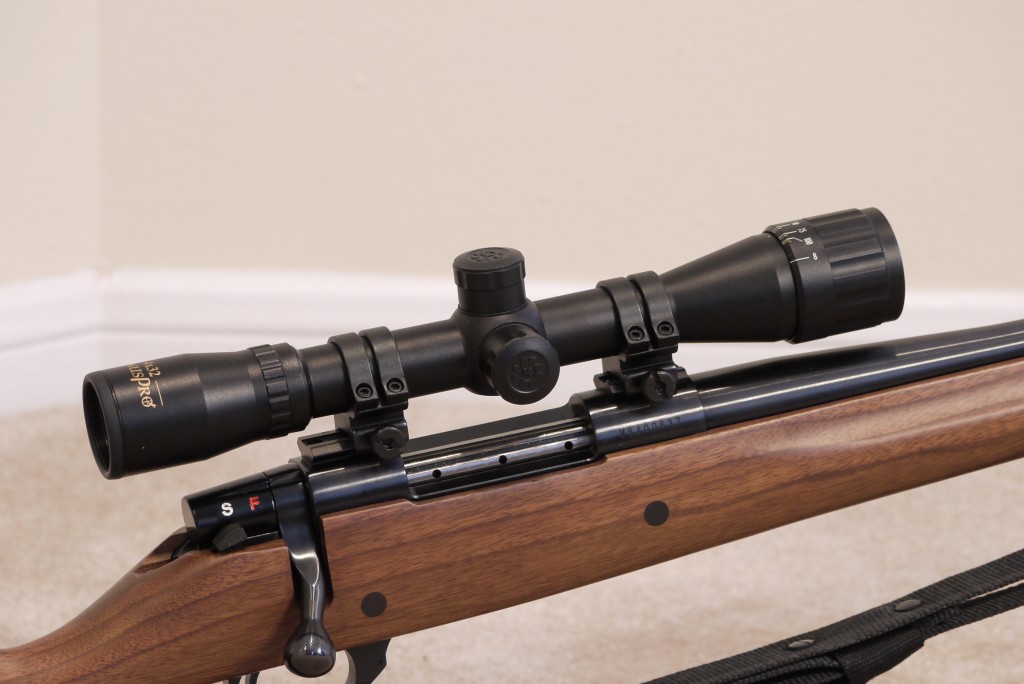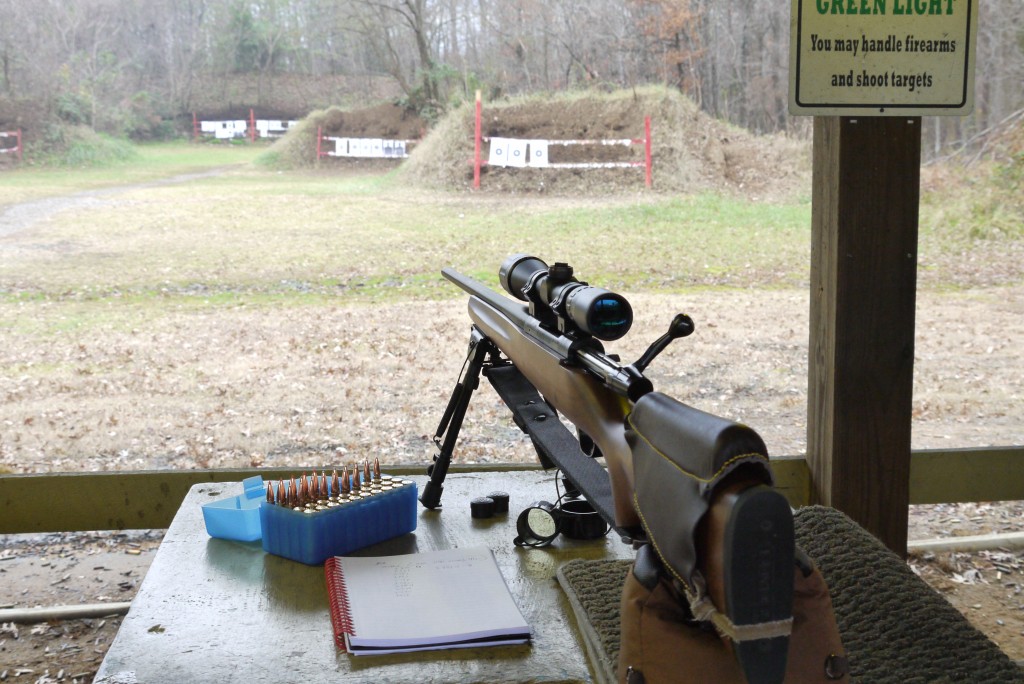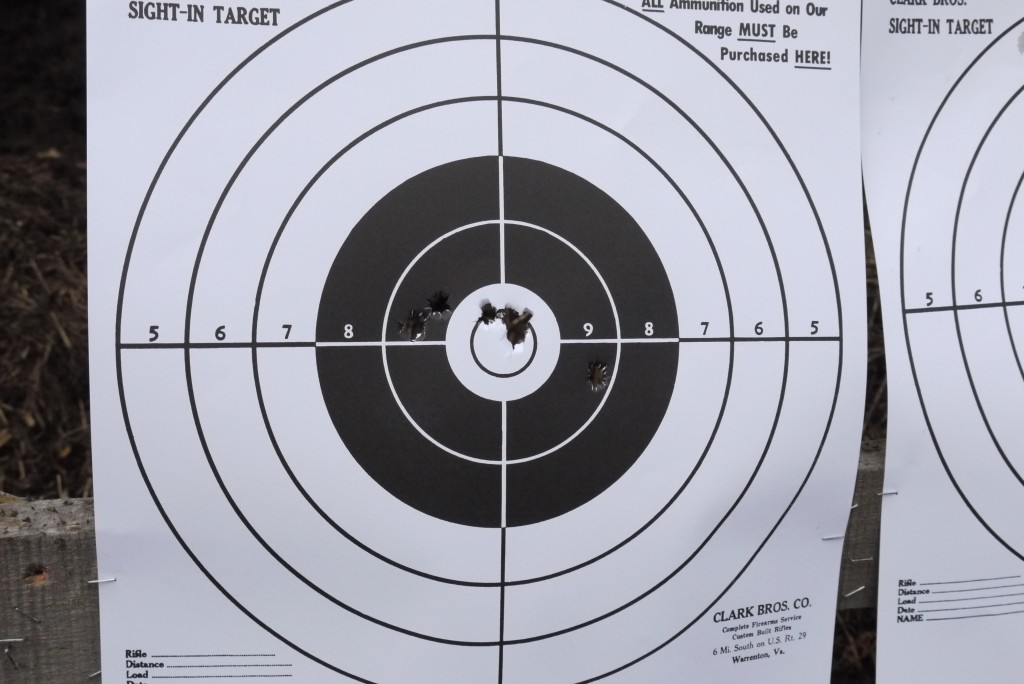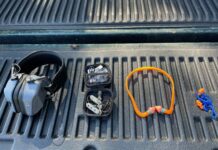 [Read in the voice of Troy McClure.] Hi, I’m Foghorn’s Weatherby Vanguard! You may remember me from such posts as my review and the 1,000 yard rifle for $500 project. I’m here today to talk about the Konus 4×32 Riflescope, a ~$65 offering from Konus geared towards hunters that Foghorn thinks will improve my accuracy a tad over that Primary Arms scope that recently beat itself to death. But will it fit the bill? Let’s find out… [/Troy]
[Read in the voice of Troy McClure.] Hi, I’m Foghorn’s Weatherby Vanguard! You may remember me from such posts as my review and the 1,000 yard rifle for $500 project. I’m here today to talk about the Konus 4×32 Riflescope, a ~$65 offering from Konus geared towards hunters that Foghorn thinks will improve my accuracy a tad over that Primary Arms scope that recently beat itself to death. But will it fit the bill? Let’s find out… [/Troy]
When you’re looking for a good “budget” scope you have to consider what the manufacturer sacrificed in order to get the price that low. More often than not the answer is “quality,” but to what degree? Let’s compare a “variable” scope (such as the Primary Arms 39×40) and “fixed” scope of equal price for a second.
For a variable scope the manufacturer needs to spend money on the mechanisms to make the scope change magnification based on user preference, and that takes away some money that could be used on nicer glass (or plastic, as the case may be) lenses. Tack on the funky illuminated reticle that Primary Arms adds to their scope and that’s even more money not being spent on making the scope rugged or accurate. The more gubbins you attach to your scope the less money you have available to focus on the scope’s primary function.
A fixed scope doesn’t have those same issues. In theory, anyway. Since the scope stays at one fixed magnification (4x in this case) the manufacturer doesn’t need to spend money on a magnification mechanism and can focus on buying quality hardware and glass.

One thing Konus did decide to drop some dosh on was an adjustable objective lens. Parallax is a gigantic pain in the ass when using scoped rifles, and an adjustable objective lens will reduce some of those issues. For more information, read my Ask Foghorn: Rifle Parallax article. Anyway, not only does Konus make the objective lens adjustable but they also decided to be nice and mark out the position (in meters AND yards) where the scope will be focused for various distances.
While adjustable objectives are nice, the issue is that on this scope it doesn’t really work all that well. Yes, adjusting the parallax is functional and cuts down on how much movement the reticle makes compared to the target, but it doesn’t eliminate that movement. A good consistent cheekweld is required if you want to stretch your rifle’s legs past 300 yards.
The reticle is a plain-Jane crosshair typically called a “duplex crosshair” as there is a thicker bar near the outside and a thinner bar for the center where they cross. This particular style of crosshair, a “30/30” (which gives the scope part of its designation), also has one interesting trait: the thin bars on the crosshair span exactly 30 MoA (30 inches at 100 yards) which enables some crude range estimation and makes the scope better for long range targets. For my loads, with a 100 yard zero on the scope (to the center cross) the small triangle on top of the bottom black bar is zeroed for just about 550 yards without needing to mess with any of the knobs.
 Of course, the true test of a scope is how well it actually works. And to answer that question I headed out to the Clark Brothers range in Warrenton, VA to zero everything in. I usually stick to a 50 yard zero, but Tyler Kee has advised me that a 100 yard zero might work best for hunting and the trip (for the First Time Hunter series) is only a few weeks away so I stretched my target out to the 100 yard post. The results were delightful.
Of course, the true test of a scope is how well it actually works. And to answer that question I headed out to the Clark Brothers range in Warrenton, VA to zero everything in. I usually stick to a 50 yard zero, but Tyler Kee has advised me that a 100 yard zero might work best for hunting and the trip (for the First Time Hunter series) is only a few weeks away so I stretched my target out to the 100 yard post. The results were delightful.
 This is the 100 yard target, the center circle is exactly 1 inch across. The first shot was low right in the black, then I over-corrected to the two high left in the black, and then one more turn of the turrets brought me high left on the center circle. Two clicks right and one click down brought me to that one ragged hole high right in the center ring where 10 rounds passed over the course of 2 hours. Yep, a slightly less than 1/2 MoA 10 round group using a rifle that cost just over $500 including a cheap $65 scope. Needless to say I was very pleased.
This is the 100 yard target, the center circle is exactly 1 inch across. The first shot was low right in the black, then I over-corrected to the two high left in the black, and then one more turn of the turrets brought me high left on the center circle. Two clicks right and one click down brought me to that one ragged hole high right in the center ring where 10 rounds passed over the course of 2 hours. Yep, a slightly less than 1/2 MoA 10 round group using a rifle that cost just over $500 including a cheap $65 scope. Needless to say I was very pleased.
The Konus scope doesn’t have a “high powered” zoom, doesn’t have an illuminated reticle, and doesn’t have mil-dot like markings on the crosshais. It’s just a simple riflescope designed primarily for hunters and target shooters on a budget, and for that it excels. If you need a cheap optic, give this one a look. Heck, it’s even cheaper than the Primary Arms.
Specifications: Konus Pro Rifle Scope 4x 32mm Adjustable Objective 30-30 Reticle
Weight: 16 oz.
Length: 12″
Adjustments: 1/4 MoA
Eye Relief: 3.4″
Tube: 1″
Ships with Mounting Rings
MSRP: $64.99
Ratings (out of five)
All ratings are relative to similar products, final rating is not mathematically derived from the preceding ratings.
Optical Clarity * * *
The picture is a tad cloudy and dull, but for a $65 scope it’s not bad at all.
Feel & Function * * * * *
The scope functions just fine. Clicks seem to be 1/4 MoA, and it holds zero OK.
Overall Quality * * * *
I can’t find many faults with the scope. The tube feels like it could use some TLC and there are a couple rough edges, but overall a very nicely finished product.
Overall Rating * * * *
You really couldn’t ask for a nicer cheap scope.
Resources





Aaaah! A talking gun. It is a salient life form and has the ability to kill I am now a gun control advocate. (sarcasm) great review by the way
I think you should make this review the first in a long running series called “Best of the Cheap Stuff.” I think I’d read them all.
I like that idea, too.
id stand behind this
Now that I had my fun with a cheap joke I have a question. I have mostly been a handgun shooter and have limited experience with scoped rifles. I was wondering what the best long range scope available is. not the best value or price just best performing best built glass available. I was just curious
looking for the best?
Start at $5500 dollars you have a choice of around a dozen scopes, and of course you can go higher for extra bells and whistles.
In this price range you will need a $3000 rifle and $400 rings, plus ammo at $10 a round just to ensure that it was not YOU who blew the shot.
Right!,
Exaggerate much? A top-o’-the-line Schmitt-Bender PMII with Horus reticle barely tops $4k. Spending any more than that is rather difficult; you’d have to be purchasing extremely specialized scopes from Henstoldt or US Optics that are roughly the size of a Hubble telescope. Your estimate on the cost of rings is also high by approximately 2x.
On the other hand, you lowballed the price of a rifle. Try double that cost for something nice from Accuracy International.
If money is no object, you can really dazzle yourself with a top-end Zeiss, Swarovski, Nightforce, Trijicon, Valdada, Schmitt & Bender or Leupold. And many others. Once you can spend upwards of $1000 (not including rings and mounts) the scope world is your oyster and you’ll have plenty of excellent choices.
The best bang:buck in the high-end scope world are probably Nightforce and Leupold Mk IV’s.
In names like Zeiss and Schmitd und Bender… you start paying for the name on the scope instead of just the quality of the scope. Don’t get me wrong, the quality is very, very good. But they know it, are proud of it, and they’re going to charge you appropriately.
Also, at the very high end, also consider warranties and service. At some point, if you are really using a scope in anything beyond pristine shooting conditions (eg, benchrest), it will need service. Leupold has an excellent warranty (lifetime of the scope) and pretty quick turn-around. Some of the other high end scope vendors… can take their time getting a service return turned around.
Best bang for your buck? SWFA…. End of story. I
Good review on the scope, Nick, and good luck on your first hunt.
Unless variable zoom it’s absolutely necessary, I’d recommend fixed power scopes for any budget. Any money not spent on that mechanism is money that can go into the glass instead. Unfortunately, Americans think of fixed power scopes as cheap, and American scope companies indulge them by not bothering to make fixed versions of their best scopes. But European shooters have a different view, and there are some really fine fixed scopes available there. Just beware the exchange rate.
I highly prefer fixed power scopes on my hunting rifles. When I need to take a shot, I don’t want to be meddling with scope adjustments. Example: On my .338, I use a Leupold 6×42 fixed. Once you learn how to shoot a fixed on game, you can set up a game shot so much more quickly than if you’re fiddling with powers, AO’s, focus, elevation adjustments, etc. I have the 6×42 zero’ed 3″ high at 200 yards. Anything under 300 yards, I aim for the heart/lung region and wait for the presentation of a shot where I can take out a shoulder. Pull trigger, done deal.
It never gets knocked out of zero, gets fogged up, etc.
i’m almost embarassed to say this. i’ve been shooting for going onto 50 years and i only have 1 scope. in my defense i don’t hunt and most of my shooting is recreational. i put a cheap barska scope on my winchester wildcat 22 and at 50 yards it does a good job. next step i suppose is to figure out how to scopr my mosin. that otta be fun.
AHHHH, how do I say this:
Foward paralax adjustment scopes have never lent themselves to tacticle usage. Target shooting, sure why not? That’s why they were invented.
Varmint shooting; well they aint shooting back so why not?
Fast Foward to tacticle: Are you Playing or Training?
Either way a FPA scope is NOT the choice. A SPA is not the choice unless there is a 500 yard shot that MUST be made.
If your eyes are under 50YO you should be shooting irons @ 200 yards
OK, someone has to teach you guys how to evaluate optics. Might as well be me.
Here’s your first test for rifle optics.
1. Fill your kitchen sink with water.
2. Put scope in kitchen sink.
3. Look for bubbles. If you see any, remove scope, test is over, scope failed.
4. Wait 10 minutes if no bubbles. Remove scope. Look for water intrusion or fog. If any, scope fails.
When you’re hunting in the West and you’re going up and down in elevation, if your scope isn’t sealed properly, you will pull off the covers one morning whilst trying to lay the crosshairs on a bull elk and see…. nothing but fog.
Once we get beyond the fogging & water issue, then we can debate all other issues in a scope, as far as I’m concerned.
Other tests to follow in subsequent comments.
Spoken from experience sounds like?
Yes.
So, this review was actually written around August of last year, when Nick still lived in in NoVa, prior to his move with Texas.
So my question is: Did you get stuck in the spam filter?
Good review, Nick, and thanks for bringing it forward in time for those of us that missed it the first time around.
OK, here’s the “box test” for scopes:
Let’s assume a scope that has been adjusted to indicate bullet strike at 100 yards (ie, the scope isn’t adjusted to have the rifle shoot high).
Foul your bore – shoot 5 rounds to confirm your initial zero is dead-on at 100 yards. You’ll want to do this in a calm wind, BTW.
Set up a target at 100 yards. Use a target with 1″ grid squares. Pick a grid intersection that is 3″ low and left from the center. Shoot a group of 3 into this point.
Now adjust the scope to come up 6″ at 100 yards. Shoot a group of 3 *at your initial point of aim* – ie, for this and for all subsequent groups, you continue to aim 3″ low and 3″ left of center. Take note of where the group went on the target and the individual shots. You’ll need to ID these first three shots at the end of the test.
Now adjust the scope to come 6″ to the right. Shoot another group of three.
Now adjust the scope to come down 6″ (3″ below centerline). Shoot a group of three.
Final adjustment: Adjust 6″ to the left (3″ left of centerline). This should be back at your initial point of aim. Shoot another group of three. See what the last group of three’s center looks like vs. your first group. Look at how far apart the centers of the groups are – are they 6″ apart? Did the groups shift left/right as you adjusted the elevation up/down? Did the elevation of the groups change as you moved the scope left/right?
If the point of impact does not repeat when you “close the box,” then if you are going to use this scope for hunting, you need to “set it and forget it.” If you change the zero in the field on a scope which doesn’t repeat, you cannot trust where you just put the zero without re-printing the point of impact.
The test as described above only ensures that the scope can “track” properly over a range of +/- 3 MOA. That’ll work for a .308 out to 250 yards or so, but doesn’t ensure proper tracking at longer ranges. Those shooting at longer ranges may wish to perform the tracking checks at the appropriate elevations.
Also, tracking can be checked without firing a single shot by taking a large sheet of paper and placing marks (brightly-colored self-adhesive 1″ dots work well) at an appropriate spacing. Fixture the rifle in sandbags or such that it remains still, and exercise the scope over the expected range of use. Obviously, this test doesn’t check for any shift that is caused by recoil, but the presence of any backlash/hysteresis in the adjustments may hint at a scope that won’t hold its adjustments under actual use.
You’re right – this is a very simple, “close range” test for a scope. Your test is a good pre-test, and I’m considering making a heavy steel base with Weaver/1903/etc bases on which I could mount scopes for your type of evaluation.
re: the limits of my test: You’ll NB from my above water/fog test, I start with very simple basics. Many cheap scopes won’t pass my basic tests. I see no reason to invest time in testing optics out to 1,000 yards or the outer limits of their adjustment range, when they won’t pass the simple stuff. That’s why the leak test is first. If the scope claims to be waterproof/fogproof and it isn’t, then I don’t need to examine how well it repeats on the box test. It won’t be on any of my rifles, and I won’t recommend it to a customer.
Your test is even more simple, and I’ll include it in my suite for pre-range scope evaluations.
BTW, my experience is that the mechanical shock of recoil is what makes errors in repeatability show up quickly.
Comments are closed.